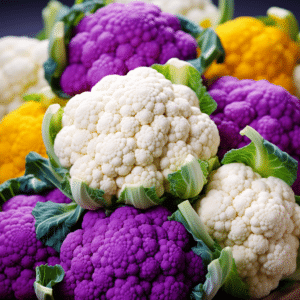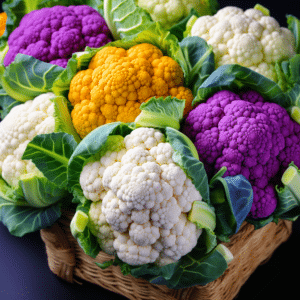
Cauliflower: Origins, Varieties, and Nutritional Benefits Unveiled
Cauliflower Varieties and Nutrition: Cauliflower was first grown in Asia, specifically Cyprus, in the 1500s. The United States did not begin manufacturing it until the twentieth century. The introduction of new cultivars is an ongoing process that began in the 1990s. Flowers of different vegetables were mated and crossbred to create cauliflower, a giant flower. China, India, the United States, Spain, Mexico, and Italy are the world’s top cauliflower producers.
Is Cauliflower Man-made?
Yes. Cauliflower is an artificial cruciferous vegetable of the Brassica Oleracea family, which include cabbages, kales, broccoli, and collard greens. They are also known as “cole” crops. Humans have been trying different innovations since time immemorial, and cauliflower results from such innovations. In this article, we will have a deeper look at the origin, benefits, recipes, and storage of cauliflower.

Description And Appearance
Cauliflower Varieties and Nutrition has a cheese curd appearance with a white, green, purple, orange, or green head surrounded by green leaves and has hundreds of varieties. It is closely related to broccoli and cabbage. There are four groups of cauliflower;
- This is the primary cauliflower cultivar from which all others have evolved. It has diverse types such as white, Romanesco, and various yellow, orange, brown, and green cultivars, which can be annual or biennial.
- Annuals are common in Europe and North America; they were developed in Germany in the 18th century. These varieties are grown every year and include snowball and Erfurt.
- Norwest European Biennials: They are common in Europe and are harvested in winter and early spring. Examples include Angers and Roscoff.
- Asian: This type was developed in India in the 19th century from the cornish variety that is now abandoned. Examples are early Benaras and early patinas.
Cauliflower Colors
White
Most cauliflowers are white, and some may imagine they are available only in this color. This variety has a white head surrounded by green leaves.
Green
Green cauliflowers can have the typical curd head shape or fractal spiral curd known as Romanesco broccoli. They have been commercially available in America and Europe since the 1990s. Their varieties include Veronica, minaret, vord, green goddess, and Alverda.
Orange
Beautiful things appear from the mess when we think things have gone wrong. A mutant in Canadian fields resulted in orange cauliflower, a rich source of beta carotene; varieties include orange boutique and cheddar.
Purple
The presence of anthocyanins in this variety makes it appear purple and has a curd-shaped head. Examples are graffiti and a purple cape. Please do not confuse it with broccoli with tiny flower buds found in Italy and Britain known as purple cauliflower.
Nutrition Values
Phytochemicals like glucosinolates and isothiocyanates can be found in cauliflower, and the vegetable itself provides a wealth of essential nutrients. It is also rich in B Vitamins, Vitamin C, E, and K. One hundred grams of cauliflower contain; 25kcal, 5gm of carbs, 1.9gm of sugar, 2gm of dietary fiber, 1.9gm of protein, 22mg of calcium, 0.42mg of iron, 15mg of magnesium, 44 mg of phosphorus, 299 mg of potassium, 30mg of sodium, 0.27mg of zinc, and 92gm of water.
Cooking Ideas
Like any other vegetable, cauliflower is versatile, and you can prepare it in many different ways. However, you should avoid cooking methods that overcook; this would destroy the phytochemicals. You can eat these vegetables raw, roast, pickle, steam, grill, sautee, or boil. You could make cauliflower rice, pizza crust, or soups using cauliflower.
Health Benefits Of Cauliflower
With loads of nutrients, cauliflower has numerous benefits to the body that include;
- Beta-carotene predominant in orange cauliflower is good for eye health and improved vision.
- It contains fibers and water that help in weight management, minimizing the risk of obesity.
- It might help in skin care and aids in slowing signs of aging, including fine lines and wrinkles.
- It helps boost nerve and memory functions. It might help slow down memory loss and dementia.
- Calcium in cauliflower might help bone health and prevent bone wastage and osteoporosis.
- It boosts blood circulation and thus improves cardiovascular health, reducing the risk of diseases such as stroke and heart failure.
- It has antioxidants that help fight diseases and infections and might help boost the immune system.
- It might help regulate blood sugars and thus reduce the deterioration of diabetes.
- Cauliflower is good for gut health. It helps with the gut lining and boosts digestion preventing disorders such as constipation and risks of colon cancer.
- It might help control high blood pressure and cholesterol.
- Cauliflower has anti-inflammatory properties that help ease swelling in inflammation-related conditions such as arthritis and asthma.
- It might help fight the growth of cells in certain cancers such as melanoma, prostate, pancreatic, esophageal, and colon cancers.
Side Effects Of Excessive Consumption Of Cauliflower
Excessive consumption of cauliflower could lead to undesirable effects such as;
- It may lead to bloating and flatulence.
- May interfere with blood thinners.
- Isothiocyanate, a primary phytochemical in cauliflower, blocks iodine absorption and may lead to hypothyroidism in persons with iodine deficiency.
- Though rare, some people suffer from cauliflower allergies. Swollen lips and tongue, rashes, hives, breathing difficulty, diarrhea, and vomiting, are some signs of allergy.

Storage
You can store cauliflower in three main ways; refrigerate, freeze, pickle, and can. Store in an airtight plastic bag or container and refrigerate for 4 to 7 days or freeze for up to eight months. Lack of proper storage could lead to shorter shelf life. Signs that your cauliflower has spoiled are; a change in color to dark brown or black, presence of molds, soft spots, slimy texture, and a pungent smell. When burying from the store, always pick healthy and fresh-looking vegetables.
Cauliflower Varieties and Nutrition was a creation of humans who crossbred different plants. More than one hundred varieties of cauliflower are available worldwide and are of different colors; green, white, orange, purple, and yellow.